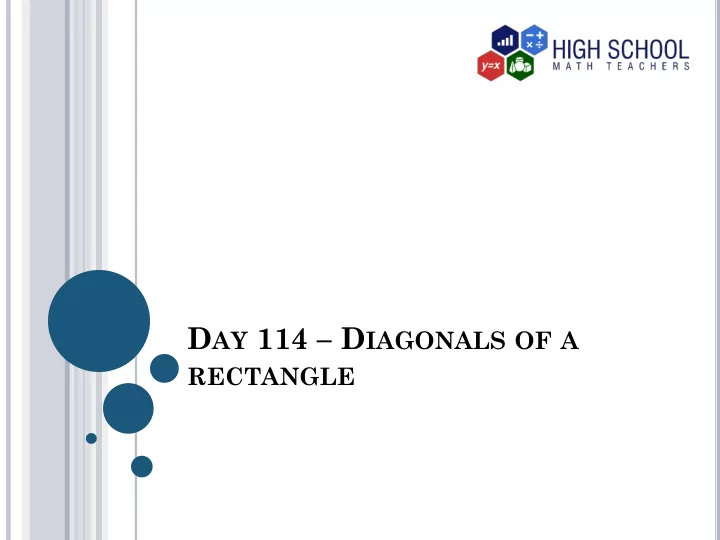

D AY 114 – D IAGONALS OF A RECTANGLE
I NTRODUCTION We have already discussed the properties of a rectangle. Among them, is that a rectangle is a parallelogram with right angles at all the four vertices. Unlike the other parallelograms whose diagonals are not equal, a rectangle has equal diagonals. In this lesson, we will prove that the diagonals of a rectangle are equal. We will also show that at the intersection of these diagonals, the opposite sides are equal and adjacent angles are supplementary.
V OCABULARY Supplementary angles These are two angles whose sum is 180 ° .
In this lesson, there are important properties of rectangles we need to remember. These properties are: Opposite sides of a rectangle are parallel. 1. Opposite sides of a rectangle are equal. 2. A rectangle has right angles at all the four 3. corners. We would also like to mention a result that we will use in this lesson, that when two triangles are congruent, their corresponding sides are equal.
Theorem: Diagonals of a rectangle are equal. To prove this theorem, we consider the rectangle below. M L J K We want to prove that 𝑁𝐿 = 𝐾𝑀.
The two diagonals divide rectangle JKLM into ∆𝐾𝐿𝑁 and ∆𝐾𝑀𝑁. Since opposite sides of a rectangle are equal, JK in ∆𝐾𝐿𝑁 is equal to ML in ∆𝐾𝑀𝑁 . KL is shared by the two triangles. Since a rectangle has right angles at its corners, ∠𝑁𝐾𝐿 = ∠𝐾𝑁𝑀 = 90 ° . By S.A.S postulate, ∆𝐾𝐿𝑁 and ∆𝐿𝑀𝑁 are congruent. JL and MK are corresponding sides. Since corresponding sides of triangles are equal, 𝑵𝑳 = 𝑲𝑴 . Therefore, diagonals of a rectangle are equal.
Example 1 Show that NP = MO. P O M N
Solution In ∆𝑁𝑃𝑄 and ∆𝑁𝑄𝑂 we have, MN = PO(opposite sides of a rectangle are equal) ∠𝑁𝑄𝑃 = ∠𝑄𝑁𝑂 (each equal to 90 ° ) MP is common in both triangles. By S.A.S postulate ∆𝑁𝑃𝑄 ≅ ∆𝑁𝑄𝑂 NP and MO are corresponding sides and thus NP = MO.
Showing that opposite angles at the intersection of the diagonals are equal. By S.S.S postulate, ∆𝐾𝑁𝑀, ∆𝐾𝐿𝑀, ∆𝐾𝐿𝑁 and ∆𝐿𝑀𝑁 are all congruent, since all these triangles share the diagonals, one longer side and a shorter side. ∠𝐾𝑀𝑁, ∠𝐾𝐿𝑀, ∠𝐾𝐿𝑁 and ∠𝐿𝑁𝑀 are corresponding angles and therefore equal. Similarly, ∠𝑀𝐾𝑁, ∠𝐿𝑁𝐾, ∠𝐾𝑀𝐿 and ∠𝑁𝐿𝑀 are corresponding angles and therefore equal. M L O J K
By A.S.A postulate, ∆𝐾𝑁𝑃 ≅ ∆𝐿𝑀𝑃 .(Two adjacent sides are congruent and the included sides are equal) ∠𝐾𝑃𝑁 and ∠𝐿𝑃𝑀 are corresponding angles and therefore equal. By A.S.A postulate, ∆𝑁𝑃𝑀 ≅ ∆𝐾𝑃𝐿. ∠𝐾𝑃𝐿 and ∠𝑁𝑃𝑀 are corresponding angles and therefore equal. Thus, opposite angles at the point of intersection of diagonals of a triangles are equal. The distance from each corner to the point of intersection is equal.
∠𝑁𝑃𝑀 and ∠𝐿𝑃𝑀 lie on a straight line and therefore their sum is 180 ° , thus they are supplementary. ∠𝐾𝑃𝑁 and ∠𝑁𝑃𝑀 lie on a straight line and therefore their sum is 180 ° , thus they are supplementary. ∠𝐿𝑃𝑀 and ∠𝐾𝑃𝐿 lie on a straight line and therefore their sum is 180 ° , thus they are supplementary. ∠𝐾𝑃𝑁 and ∠𝐾𝑃𝐿 lie on a straight line and therefore their sum is 180 ° , thus they are supplementary.
Example Find the value of 𝑦 in the figure below. A B ° 2𝑦 + 40 𝑦 + 80 ° C D Solution Since opposite angles at the point of the intersection of the diagonals are equal, 2𝑦 + 40 = 𝑦 + 80 2𝑦 − 𝑦 = 80 − 40 𝑦 = 40
HOMEWORK Find the value of the angle marked with letter a. 29 ° a
A NSWERS TO HOMEWORK 29 °
THE END
Recommend
More recommend